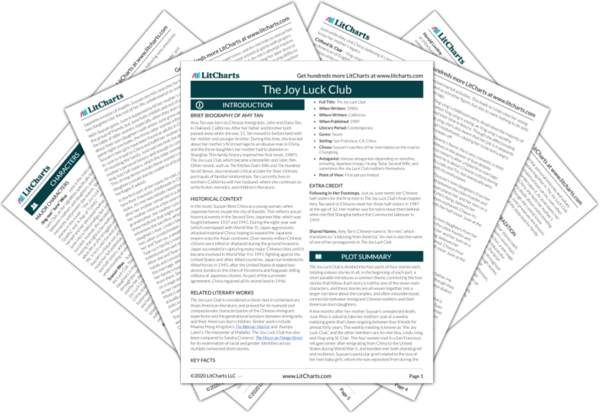Summary
Analysis
Waverly worries that she will blend in too much on her trip to China, and airport officials won’t let her back into the United States; Lindo scoffs and says that Waverly doesn’t even need to open her mouth to reveal that she’s an outsider. Despite Lindo’s attempts to nurture Waverly’s Chinese heritage, Waverly barely knows Mandarin and has an American haughtiness when she talks. Lindo argues that “only her skin and hair are Chinese. Inside – she is all American-made.”
Lindo wanted her daughter to be half Chinese and half American, but now understands how impossible it is to achieve a balanced combination. Waverly is so influenced by her birth country that there’s no room for Chinese values to fit in.
Themes
Before Waverly’s wedding, Waverly forces Lindo to get her hair cut at a fancy San Francisco salon. The stylist doesn’t even try to converse with Lindo, thinking she can’t speak English. Instead, he fields all questions about Lindo’s hair to Waverly, who in turn, pretends like she has to translate (even though she knows Lindo speaks English). Lindo smiles politely and uses what she calls her “American face,” the blank expression that Americans expect Chinese people to have. The stylist comments that Lindo and Waverly look alike, which makes Lindo genuinely smile, revealing her “Chinese face.”
Having different public “faces” is common in immigrant experiences, since Americans’ (rather lazy) misperceptions lead them to devalue immigrant people’s worth so frequently. It’s seemingly easier to pretend to fit American’s expectations and not cause problems. The consequence, though, is that no one then sees an immigrant’s authentic expression, and that authentic expression itself becomes difficult to access.
Themes
When left alone, Lindo thinks about the similarities between she and Waverly, as mother and daughter; then, she thinks about her own mother and her. Before they were separated, Lindo’s mother told her that she could read Lindo’s fortune in her face, and that it was similar to hers. Lindo wonders what her mother would say, seeing Lindo’s old, drooping face now. Lindo thinks about how hard it is to keep a Chinese face in America, when everyone sees immigrants differently.
Though they have had very different life experiences, mothers and daughters share indisputable behaviors, features, and heritages. Still, the immigrant experience is unique because they must juggle multiple personalities to survive in a new society.
Themes
When first traveling to America, Lindo pays an American-raised Chinese girl to teach her the rules of survival. She’s told to first marry an American citizen and eventually have a baby, which will keep immigration officials away. Lindo starts work at a fortune cookie factory in San Francisco, where she meets An-mei. Through An-mei’s church, Lindo meets Tin Jong, a nice man who unfortunately speaks Cantonese, not Lindo’s Mandarin. Despite the language barrier, they learn to laugh together, and eventually marry and start a family. When Waverly is born, after two boys, Lindo is overwhelmed by how much they look alike, and names Waverly after the street they lived on, so no one would question that Waverly belonged in America.
Lindo’s value in America is based on her ability to marry well, which again reduces her to her gender. Her relationship with Tin is interesting to the discussion of language, as it shows the nuances within Chinese dialects that most non-Chinese speakers don’t realize. Though they’re both from mainland China, Lindo and Tin can’t communicate in the same language. Still, they find a shared language in laughter and affection. Waverly’s birth signals Lindo’s completion of ‘the American Dream,’ yet Lindo is afraid that Waverly will be unwelcomed due to her Chinese appearance.
Themes
Get the entire The Joy Luck Club LitChart as a printable PDF.

Back in the parlor, Lindo complains about Waverly’s crooked nose, inherited from Lindo, but Waverly likes it, saying it makes them look “devious… people just know we’re two-faced.” Lindo considers the idea of having two faces again, and wonder why they must always sacrifice one face to show the other.
Waverly enjoys the idea of seeming mysterious, because she’s always been able to switch between American and Chinese identity without consequence. As an immigrant, Lindo does not have the luxury of choosing which face she wears, but also wonders why it is that she can’t wear “both” of her faces, as those two faces really do speak to her total experiences.
Themes












